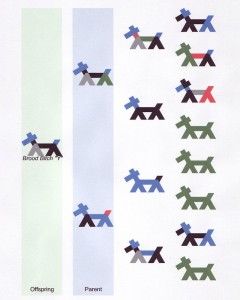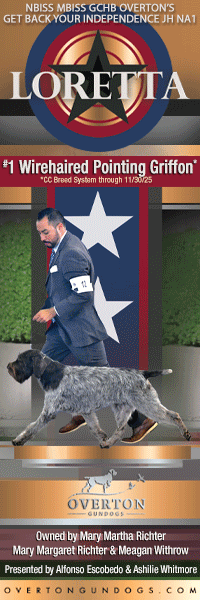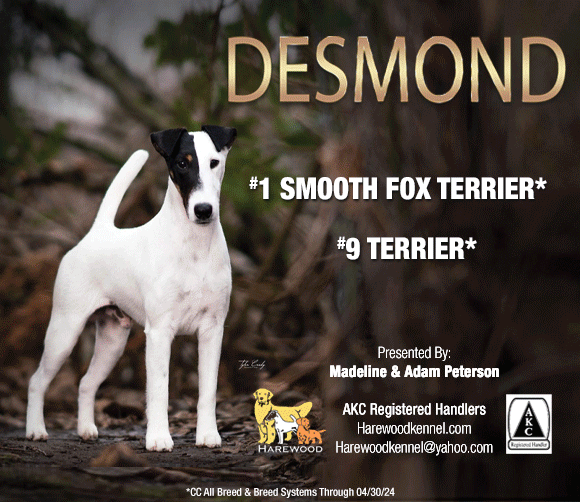Breeding Tips from Dr. Carmen Battaglia
By Amy Fernandez
 Insightful judges notice stuff and that skill is not uniformly distributed throughout the judging fraternity. The entire goal of this arduous business of showing dogs is the improvement of our breeding stock. And, theoretically, judges are there to point the way. The good ones do more than notice problems that breeders, owners, and exhibitors should be aware of, they consider the underlying reasons. That brings me to Carmen Battaglia–someone with a multi-faceted role in the sport. But we will stick to the judging side of it for the moment.
Insightful judges notice stuff and that skill is not uniformly distributed throughout the judging fraternity. The entire goal of this arduous business of showing dogs is the improvement of our breeding stock. And, theoretically, judges are there to point the way. The good ones do more than notice problems that breeders, owners, and exhibitors should be aware of, they consider the underlying reasons. That brings me to Carmen Battaglia–someone with a multi-faceted role in the sport. But we will stick to the judging side of it for the moment.
Carmen came from a background in Working/Herding breeds. It goes without saying that structure counts big in his evaluations. Recently he shared a few observations. His main message was that little tweaks often have a big impact on our basic husbandry practices.
“Dogs are barefoot, we are not. No one thinks about that. When you have a growing puppy and you want to protect his joint, he needs to wear shoes.” Ok…what? Dog booties are actually a popular fashion accessory among pet owners. Unfortunately, dogs hate those little shoes and remove them ASAP. But Carmen makes a valid point. Hard surfaces take a toll on feet and joints. Ask anyone who is on their feet all day. Foot pain inevitably leads to joint and back pain because too much stress on bones results in damage to weight bearing tendons and ligaments. “How long would our joints last if we were always barefoot?”
Luckily, dogs come equipped with built in shoes, and as Carmen points out “The footpads grow and thicken as the puppy grows and develops; and by the time the puppy is an adult it has a built-in sneaker.” There’s a caveat here, which came to Carmen’s attention as a judge.
“I check the shoulders on every dog I judge, (Regardless of breed, this essential part of evaluation is overlooked too often). “Shoulder layback, length of upper arm. Many times, I say to myself, ‘This dog is built properly, he should move well,’ and then he doesn’t. And then I look down at the feet and see these long nails.”
So many dogs are reluctant to walk on mats, and maybe this is the reason. Check the nails. Carmen says, “You can spot long nails immediately because the dog will not put his feet down evenly. The dog will come at you east-west or move with excessive front lift. Those long nails get stuck in the ridges of the mat. If you always keep them short so that the nails never touch the floor, the pads get nice and thick and this never becomes a problem. If not, it will impact gait and potentially damage the joints.”
Cropping and docking has been a giant AR target forever. And as Carmen admits, “AKC plays defense on this issue and that is a losing strategy in any courtroom. I have been an expert witness too many times.” Regardless of the case, lawyers have plenty of paid courtroom experts willing to offer a convincing argument on any issue–and they have plenty of credentials and credibility. So, Carmen is spot-on with that assessment.
“I have been thinking about this. The ears on Danes and Dobermans must be cropped to stand, but German Shepherds have the same problem of soft ears. You can do all kinds of things to make them stand, but one reason why ears don’t stand like they should is because the muscle controlling ear carriage is weak. That is certainly true for German Shepherds. I tried this experiment with my own puppies, and it works.”
Splinting, taping or glueing the ears will hold them in the correct position and keep the cartilage from breaking down. But that’s never the end of the story. Just when everything seems good to go, ears wilt. This can go on for months. So, here’s an idea from Carmen. “If you want the ears to be strong and standing, all you need to do is isolate that puppy for awhile in a location where he can hear his pack but he cannot see them. Anytime he hears a noise, he will flex those ear muscles. After ten days or two weeks, when you unwrap those ears they will be strong.”
This is something that we should seriously consider. When ear cropping was banned in England, virtually overnight by royal decree, it nearly led to the demise of some of the nation’s oldest breeds. And it was the death knell for the White English Terrier. Breeds that came back from the brink like the Bull Terrier were saved because breeding for ear set and ear carriage is not that challenging. The BTCA didn’t quite jump into that task back in 1895. However, they discovered that AKC was not on their side of the argument. It also helped that a flood of valuable English dogs suddenly enlarged the American gene pool when they were all disqualified in England.
I discovered this firsthand when AKC recognized the Chinese Crested. The breed had been in and out of Miscellaneous for decades, and AKC was obviously not too interested. Among the many conditions they demanded was identical ear carriage on both varieties. Never mind the fact that they have admitted breeds allowing variations before and since, and both the Kennel Club and FCI standards allowed for both. That was the deal, take it or leave it. Within a couple of generations, American Powderpuffs had erect ears. It wasn’t a miracle, it was selective breeding.
The goal of dog breeding requires a combination of nature and nurture and, smart selection is the only route to the major pieces of the equation. Visit breedingbetterdogs.com for a treasure-trove of assistance with this part of the challenge. For now, here’s another crucial takeaway from Carmen, who spends a lot of time meeting with geneticists.
“In a three generation pedigree ninety percent of the genes will come from ancestors in those first three generations. That translates into 14 ancestors. So if you are seeking to improve a certain trait in your bloodline you must focus on those ancestors. I use that stick dog pedigree program because it shows exactly the percentage of a trait you really have and if you can get it in 10 or 12 of those ancestors you have concentrated the genes for that trait.
Everyone pays attention to the sire and dam but do they always research the contributions beyond there? And there is no excuse these days because we have access to so many resources that were unimaginable a few years ago.
Health testing is just part of the package. Our goal is a healthy dog that exemplifies true type.
Short URL: https://caninechronicle.com/?p=291488
Comments are closed












